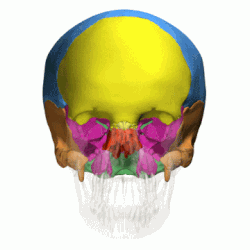
Back قحف عصبي Arabic Neurocrani Catalan Mozkovna Czech Hjernekasse Danish Neurocráneo Spanish Neurokranio Basque کاسه مغز Persian Aivokoppa Finnish Neurocrâne French Neurocranio Galician
| Neurocranium | |
|---|---|
 The eight bones that form the human neurocranium. | |
 The eight cranial bones. (Facial bones are shown in transparent.)
Yellow: Frontal bone (1)
Blue: Parietal bone (2)
Purple: Sphenoid bone (1)
Orange: Temporal bone (2)
Green: Occipital bone (1)
Red: Ethmoid bone (1) | |
| Details | |
| Identifiers | |
| Latin | neurocranium |
| TA98 | A02.1.00.007 |
| TA2 | 354 |
| FMA | 53672 |
| Anatomical terms of bone | |
In human anatomy, the neurocranium, also known as the braincase, brainpan, or brain-pan,[1][2] is the upper and back part of the skull, which forms a protective case around the brain.[3] In the human skull, the neurocranium includes the calvaria or skullcap. The remainder of the skull is the facial skeleton.
In comparative anatomy, neurocranium is sometimes used synonymously with endocranium or chondrocranium.[4]
- ^ "Brainpan - Medical Definition and More from Merriam-Webster". Merriam-Webster/Medical.
- ^ Nyiszli, Miklos (2011). Auschwitz: A Doctor's Eyewitness Account. New York: Arcade Publishing.
- ^ Sadler, Thomas W. (February 2009). Langman's Medical Embryology. Lippincott Williams & Wilkins. p. 173. ISBN 978-0781790697.
- ^ Kent, George C.; Carr, Robert K. (2001). Comparative Anatomy of the Vertebrates (9th ed.). New York, NY: McGraw-Hill. ISBN 0-07-303869-5.